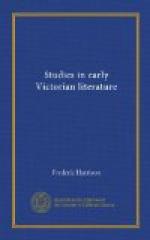The most obvious and superficial change in literature is the extreme diversity of its form. There is no standard now, no conventional type, no good “model.” It is an age of “Go-as-you-please,” and of tous les genres sont bons, surtout le genre ennuyeux. In almost any age of English literature, or indeed of any other literature, an experienced critic can detect the tone of the epoch at once in prose or verse. There is in them an unmistakeable Zeit-Geist in phraseology and form. The Elizabethan drama, essay, or philosophy could not be mistaken for the drama, essay, or philosophy of the Restoration; the heroic couplet reigned from Dryden to Byron; Ciceronian diction reigned from Addison to Burke; and then the Quarterlies, with Southey, Lamb, Scott, De Quincey, Coleridge, Sydney Smith, and Leigh Hunt, introduced a simpler, easier tone of the well-bred causeur, as free from classical mannerism as it was free from subtle mechanism or epigrammatic brilliance. Down to about the death of Scott and Coleridge, almost any page of English prose or verse could be certainly attributed to its proper generation by the mark of its style alone.
The Victorian literature presents a dozen styles, every man speaking out what is in him, in the phrases he likes best. Our Zeit-Geist flashes all across the heavens at once. Let us place a page from Sartor Resartus beside a page from Macaulay’s History of England, or either beside a page from Arnold’s Literature and Dogma or one from the Stones of Venice. Here are four typical styles in prose, each of which has been much admired and imitated; yet they differ as widely as Shelley from Ovid, or Tennyson from Pope. Again, for verse, contrast Paracelsus with The Princess—poems written about the same time by friends and colleagues. Compare a poem of William Morris with one by Lewis Morris. Compare Swinburne’s Songs and Sonnets with Matthew Arnold’s Obermann; Rudyard Kipling’s Ballads with The Light of Asia. Have they any common standard of form, any type of metre? The purists doubt as to the style of Carlyle as a “model,” but no one denies that the French Revolution and Hero-Worship, at least in certain passages, display a mastery over language as splendid as anything in our prose literature. Exactly the same might be said also of Esmond, and again of Silas Marner, and again of the Seven Lamps of Architecture. Yet all of these differ as widely as one style can differ from another. Fifine at the Fair, and The Angel in the House, have each fervent admirers. No! there is no recognised “model” either in verse or in prose.




